Sharing a small bedroom doesn’t mean your kids have to sacrifice comfort, privacy, or style.
With the right design tricks and smart storage solutions, you can create a space that feels spacious, organized, and uniquely theirs.
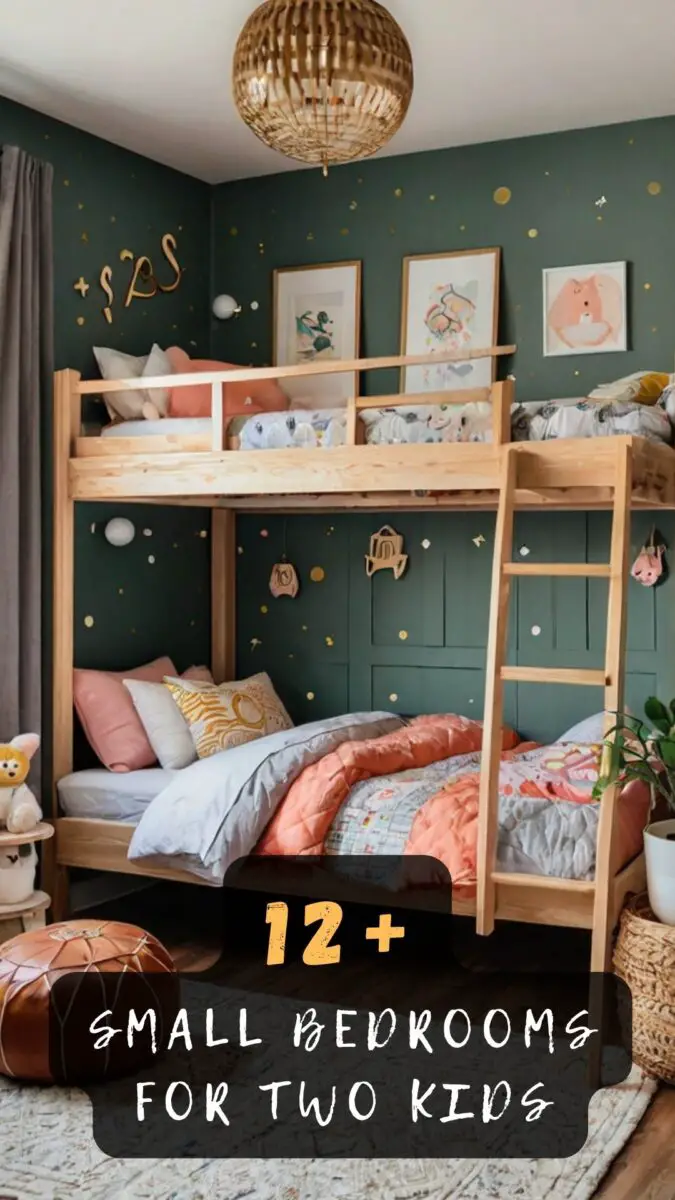
Vertical Bunk Beds With Hidden Storage Compartments
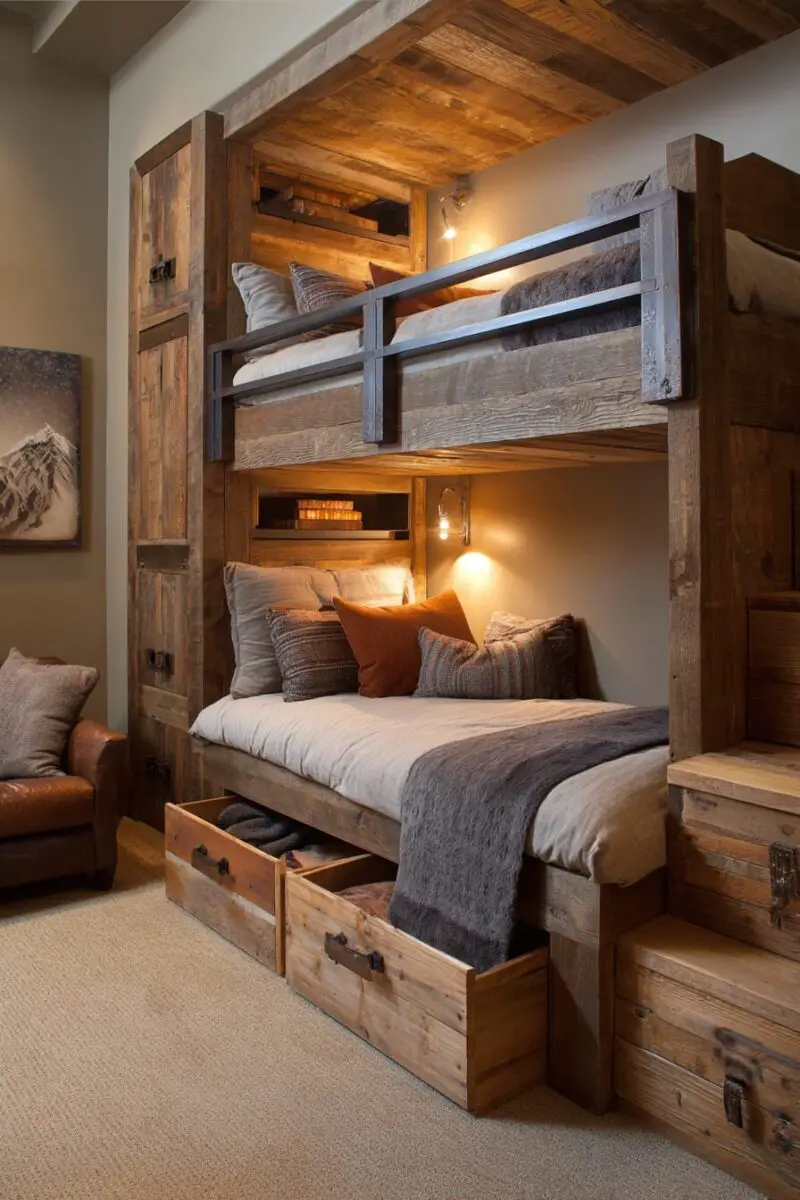
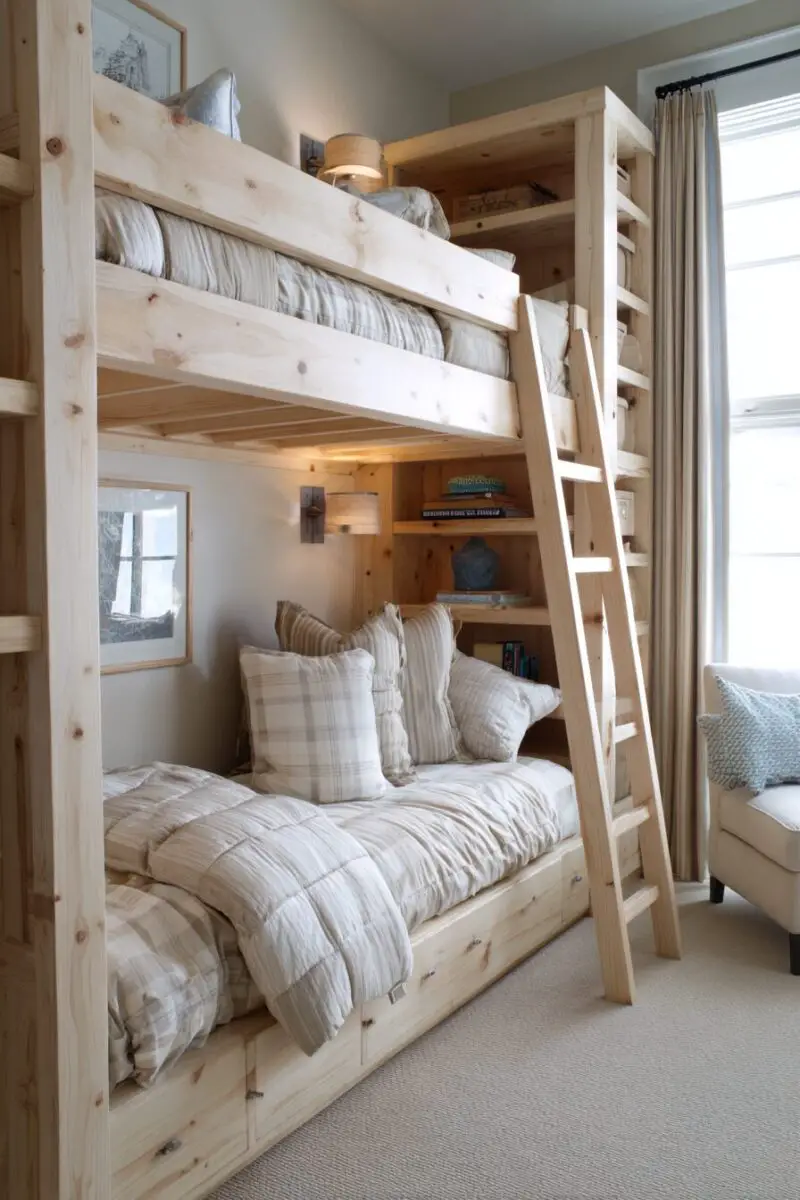
Bunk beds aren’t just about saving floor space anymore – they’re secret storage goldmines waiting to be discovered.
Modern bunk bed designs now feature built-in drawers that slide out from the base, creating instant storage for clothes, toys, and books without taking up any additional room.
You can find models with stairs instead of ladders, where each step doubles as a storage box for shoes, games, or seasonal clothing.
The space underneath the bottom bunk transforms into a cozy reading nook when you add some cushions and string lights.
Built-in shelving units on the sides of bunk beds provide easy access to bedtime stories and personal belongings for both kids.
Some innovative designs include pull-out desks that tuck neatly under the bottom bunk, giving each child their own workspace without crowding the room.
Safety remains paramount, so look for designs with rounded corners, sturdy guardrails, and non-slip surfaces on stairs.
The key is choosing a bunk bed system that grows with your children – many models can later separate into two individual beds when you move to a larger space.
Color coordination helps tie everything together, so pick a neutral base color for the bed frame and let your kids personalize their individual spaces with colorful bedding and accessories.
Modern materials like engineered wood and metal combinations offer durability while maintaining a sleek, contemporary appearance that won’t look outdated in a few years.
Smart bunk bed designs also incorporate charging stations and small LED reading lights, making nighttime routines easier for both children.
This approach maximizes every square inch of vertical space while giving each child defined areas they can call their own.
Madison’s Current Obsessions
11+ Ultimate Chill Room Ideas for Your Cozy HideawayRoom Divider Magic: Creating Personal Spaces Without Walls
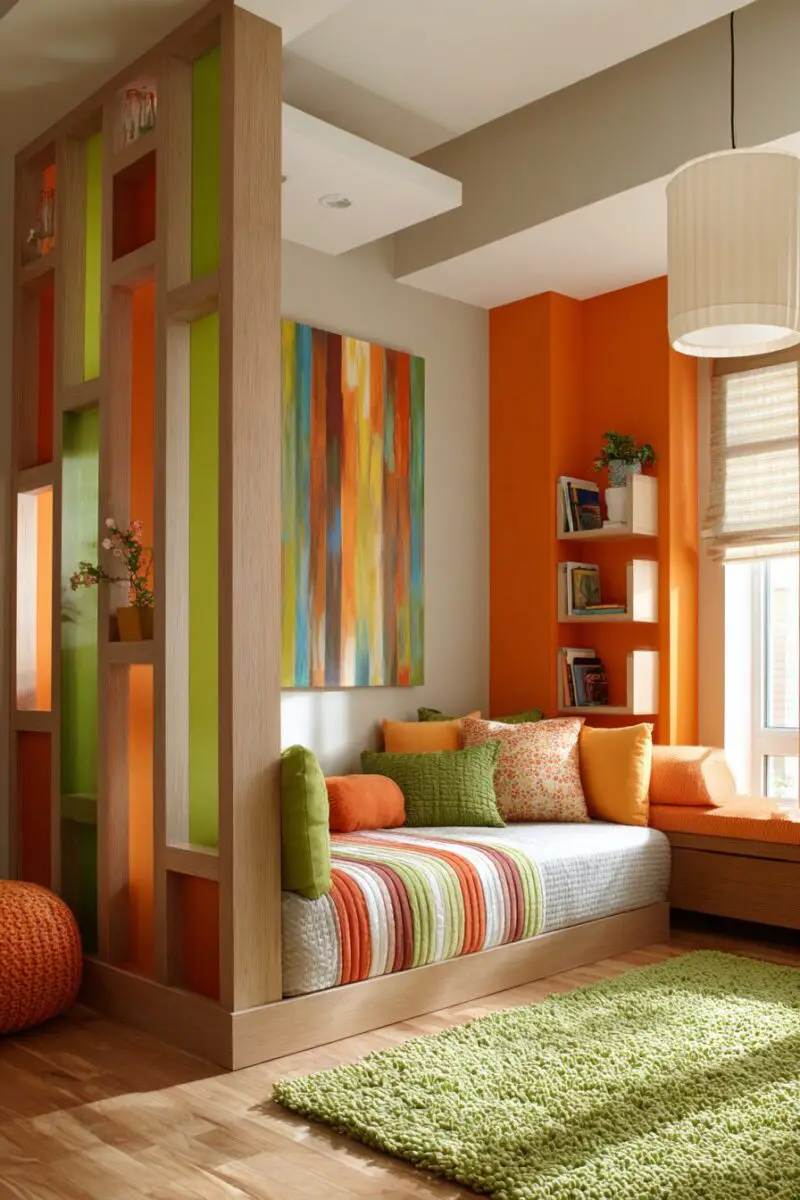
Physical barriers don’t have to be permanent walls – creative room dividers can instantly give each child their own private sanctuary.
Fabric curtains hung from ceiling tracks offer the most flexible solution, allowing kids to open up the space during playtime and close it off for privacy during homework or sleep.
Bamboo folding screens add a natural, zen-like element while being lightweight enough for kids to move around as needed.
Tall bookcases positioned perpendicular to walls serve double duty as both storage and room dividers, creating distinct zones while keeping the space feeling open and airy.
Hanging panels made from colorful fabric or even string lights create a whimsical separation that feels more like decoration than division.
Temporary walls made from tension rods and tapestries give older kids the privacy they crave while remaining completely removable.
Plants on tall stands or hanging from the ceiling create natural boundaries while improving air quality and adding life to the room.
Open shelving units work brilliantly as dividers because they maintain visual flow while providing storage and display space for both children.
Beaded curtains or macrame hangings offer a bohemian touch that’s especially popular with tweens and teens who want something unique.
The beauty of these solutions lies in their adaptability – you can easily reconfigure or remove them as your children’s needs change over time.
Some families rotate different divider styles seasonally, keeping the room feeling fresh and giving kids something new to enjoy throughout the year.
This flexibility means you’re not locked into one design choice, and the room can evolve with your children’s changing personalities and preferences.
Design Your Dream Room in Minutes! By DreamyHomeStyle
🏡 Start Creating FREE →Madison’s Current Obsessions
Why Your Bedroom Deserves A Grown Woman Makeover Right Now!Vertical Storage Walls: Going Up Instead of Out

When floor space is limited, your walls become prime real estate for organization and storage solutions.
Floor-to-ceiling shelving units maximize every inch of wall space while creating an impressive focal point that makes the room feel larger and more organized.
Modular cube systems allow you to customize storage configurations based on each child’s specific needs – some cubes can hold books while others accommodate toys or clothing.
Floating shelves at varying heights give both children easy access to their belongings while creating an interesting visual display that breaks up blank wall space.
Pegboard walls painted in fun colors provide endless possibilities for hanging backpacks, hats, art supplies, and small baskets filled with treasures.
Wall-mounted cabinets with doors keep clutter hidden while providing substantial storage for items you don’t want on display.
Magnetic strips attached to walls can hold small metal toys, craft supplies, or even lightweight books, adding function without bulk.
Corner shelving units make use of often-wasted space while providing perfect spots for stuffed animals, plants, or decorative items.
Hook systems at child-friendly heights encourage kids to hang up clothes, towels, and bags, teaching responsibility while maintaining organization.
Vertical storage towers that fit between furniture pieces maximize narrow spaces and can hold everything from shoes to school supplies.
Wall pockets made from fabric or clear plastic keep smaller items organized and visible while taking up zero floor space.
The trick is creating a system that’s both functional for daily use and visually appealing enough to make the room feel intentional rather than cluttered.
Madison’s Current Obsessions
Sleep among the Trees: 55 Nature-Loving Forest Bedroom Designs to Bring the Outside InUnder-Bed Storage Systems: Hidden Treasures Beneath
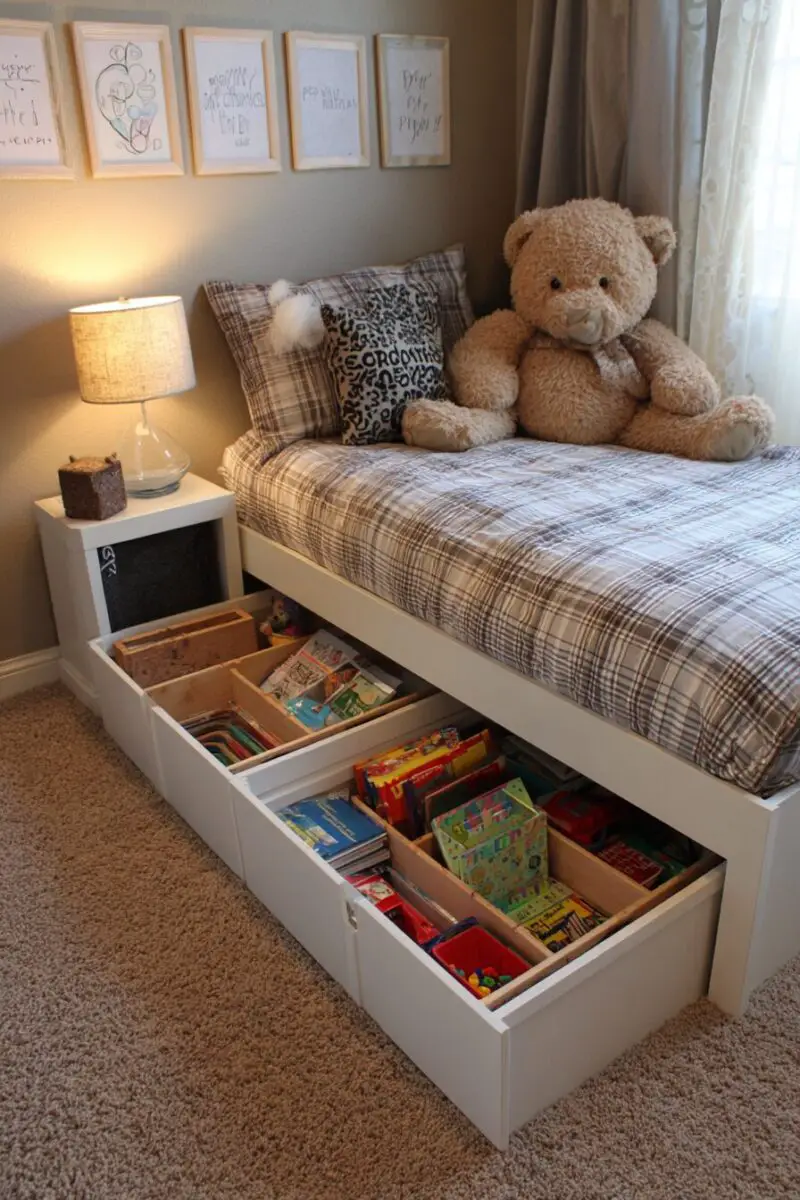

The space under beds represents one of the most underutilized storage opportunities in any bedroom, especially when you get creative with organization systems.
Rolling drawer units that slide perfectly under standard bed frames provide easy access to seasonal clothing, extra bedding, or toys that aren’t used daily.
Vacuum-sealed storage bags can compress bulky items like winter coats or comforters, allowing you to store much more in the same space.
Clear plastic containers with lids stack efficiently while letting you see contents at a glance, making it simple for kids to find what they need.
Raised bed platforms with built-in storage compartments turn the entire bed into a storage powerhouse without requiring any additional floor space.
Under-bed shoe organizers keep footwear sorted and easily accessible while preventing the dreaded pile of shoes by the door.
Storage ottomans that fit partially under beds can be pulled out to serve as seating while providing hidden storage for games, books, or craft supplies.
Sliding baskets on tracks create a custom storage system that maximizes the full depth of under-bed space while remaining easily accessible.
Cedar blocks or sachets placed in under-bed storage help keep stored items fresh and protect against moisture or pests.
Labeled storage systems teach kids organizational skills while making it easier for them to maintain their own spaces independently.
Some families designate specific under-bed areas for each child, giving them personal storage space that feels private and special.
The key is choosing storage solutions that are low enough to fit comfortably under beds while being sturdy enough to handle regular use by active children.
Madison’s Current Obsessions
13 Rustic Ideas For Your Bedroom!Convertible Furniture: One Piece, Multiple Functions
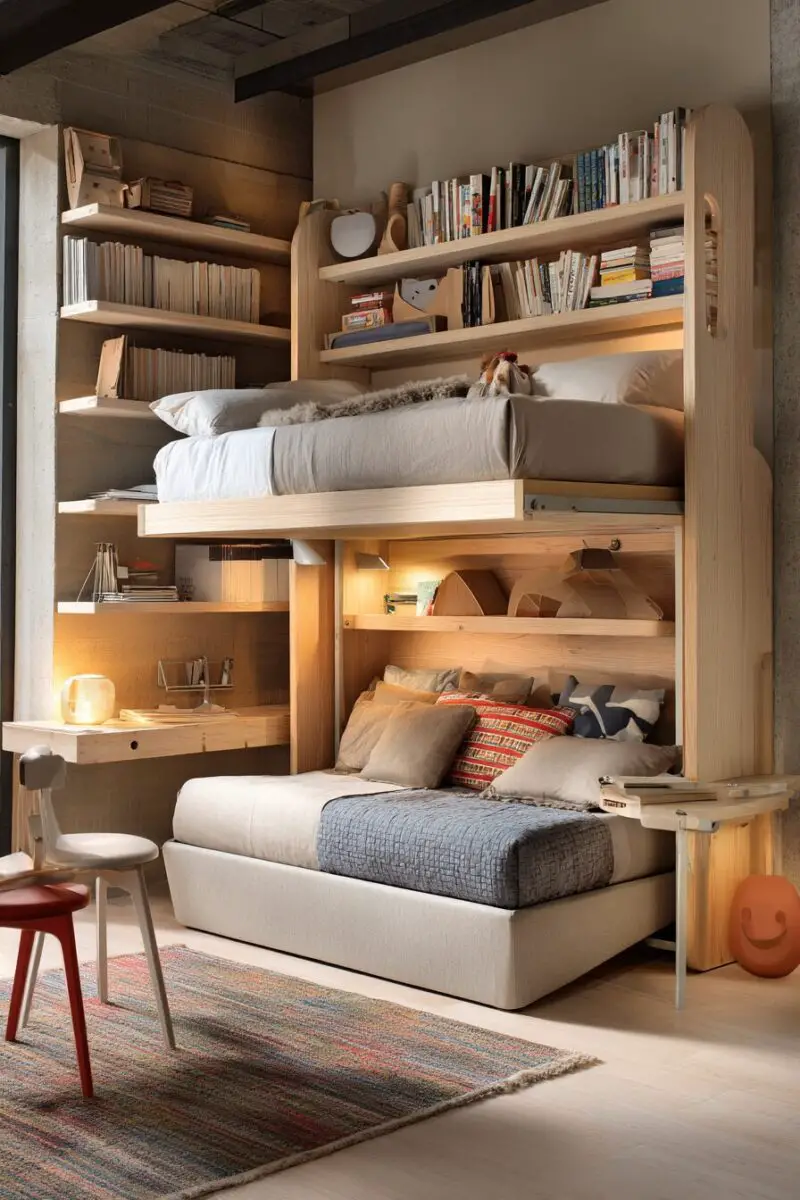
Multi-functional furniture pieces are absolute game-changers in small shared bedrooms where every square foot needs to work overtime.
Ottoman beds provide comfortable seating during the day and transform into sleeping spaces for sleepovers or when friends visit.
Desk-bed combinations feature a full workspace on top with a comfortable sleeping area below, perfect for older kids who need dedicated study areas.
Storage benches at the foot of beds provide seating for putting on shoes while hiding away extra blankets, pillows, or seasonal clothing.
Nesting tables can be spread around the room when needed for activities and then stack together to save space when not in use.
Folding desks mounted to walls flip down when needed for homework and fold flat against the wall to maximize play space.
Murphy beds that fold into walls are the ultimate space-savers, though they work best for older children who can safely operate the mechanism.
Transforming chairs that unfold into floor mats give kids flexible seating options for reading, gaming, or hanging out with friends.
Modular furniture systems can be reconfigured into different arrangements depending on the activity, keeping the room fresh and functional.
Storage cubes with removable tops serve as seats, tables, and storage containers all in one compact package.
Expandable tables grow larger for projects and homework, then shrink back down to save space when the work is done.
The investment in quality convertible furniture pays off over time as these pieces adapt to changing needs rather than requiring replacement as kids grow.
Madison’s Current Obsessions
How to Achieve a Cozy Boho Mid-Century Modern Bedroom Look!Color-Coded Zones: Personal Identity in Shared Spaces
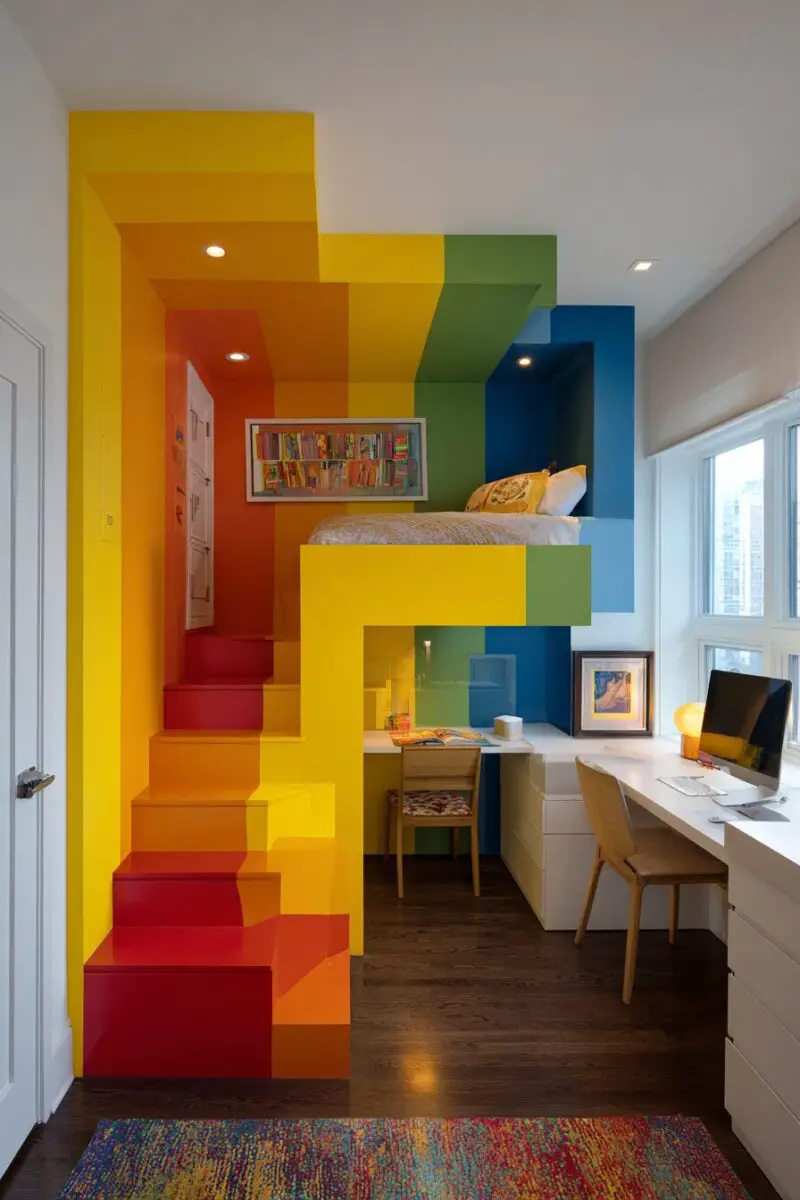
Assigning specific colors to each child creates clear ownership and personal identity within the shared space without requiring physical barriers.
Each child gets their own signature color that appears on their bedding, storage bins, wall art, and personal accessories throughout their designated areas.
Color coding extends to practical items like towels, toothbrushes, and school supplies, reducing arguments about whose belongs to whom.
Painted accent walls behind each bed create distinct zones while maintaining the room’s overall cohesive design aesthetic.
Colored tape on floors can subtly define personal spaces and activity areas without being permanent or expensive to change.
Storage solutions in each child’s assigned color make organization more intuitive and help maintain long-term tidiness in the shared space.
Wall decals and removable wallpaper in coordinating colors add personality without the commitment of permanent paint or the expense of redecoration.
Lighting solutions like colored lampshades or string lights in each child’s color create cozy personal atmospheres within the larger room.
Even shared items can incorporate both colors through patterns, stripes, or alternating sections that represent both children equally.
This system grows with children as they develop stronger preferences and can easily evolve by simply swapping out colored accessories and textiles.
Parents find that color coding reduces daily conflicts and helps children take ownership of their belongings and spaces more naturally.
The psychological benefits include increased personal responsibility and pride in maintaining their designated areas, making the shared living situation more harmonious for everyone involved.
Madison’s Current Obsessions
13 Ways To Infuse Blue & White Into Your Living RoomLoft Beds: Maximizing Floor Space for Play

Loft beds elevate sleeping areas to create valuable floor space underneath for play, study, or additional storage without expanding the room’s footprint.
The space beneath a loft bed transforms into a cozy playhouse, fort, or reading nook that feels special and separate from the rest of the room.
Built-in play features like slides, climbing walls, or hanging swings turn bedtime destinations into adventure zones that kids actually look forward to using.
Curtains or fabric panels around the base create an enclosed play area that feels private and magical, perfect for imaginative games or quiet activities.
Study areas beneath loft beds provide dedicated homework spaces with built-in desks, shelving, and proper lighting for focused academic work.
Some loft bed designs incorporate full wardrobes or dressers underneath, eliminating the need for separate furniture pieces and maximizing available floor space.
Safety features like sturdy railings, wide ladders with comfortable steps, and rounded corners ensure that elevated sleeping remains secure for active children.
The open floor space can accommodate larger toys like play kitchens, train tables, or craft stations that would otherwise crowd a small room.
Multiple loft beds in the same room create individual retreat spaces for each child while maintaining an open, airy feeling throughout the shared space.
Height adjustments on some models mean the bed can grow with your child, starting lower for younger kids and raising higher as they become more comfortable with elevation.
This approach works especially well for creative kids who need space for art projects, building activities, or other hands-on hobbies that require floor room to spread out.
Madison’s Current Obsessions
13 Lavish Luxury Master Bedroom Decor Ideas To Inspire YouCeiling-Mounted Storage Nets: Floating Organization Above
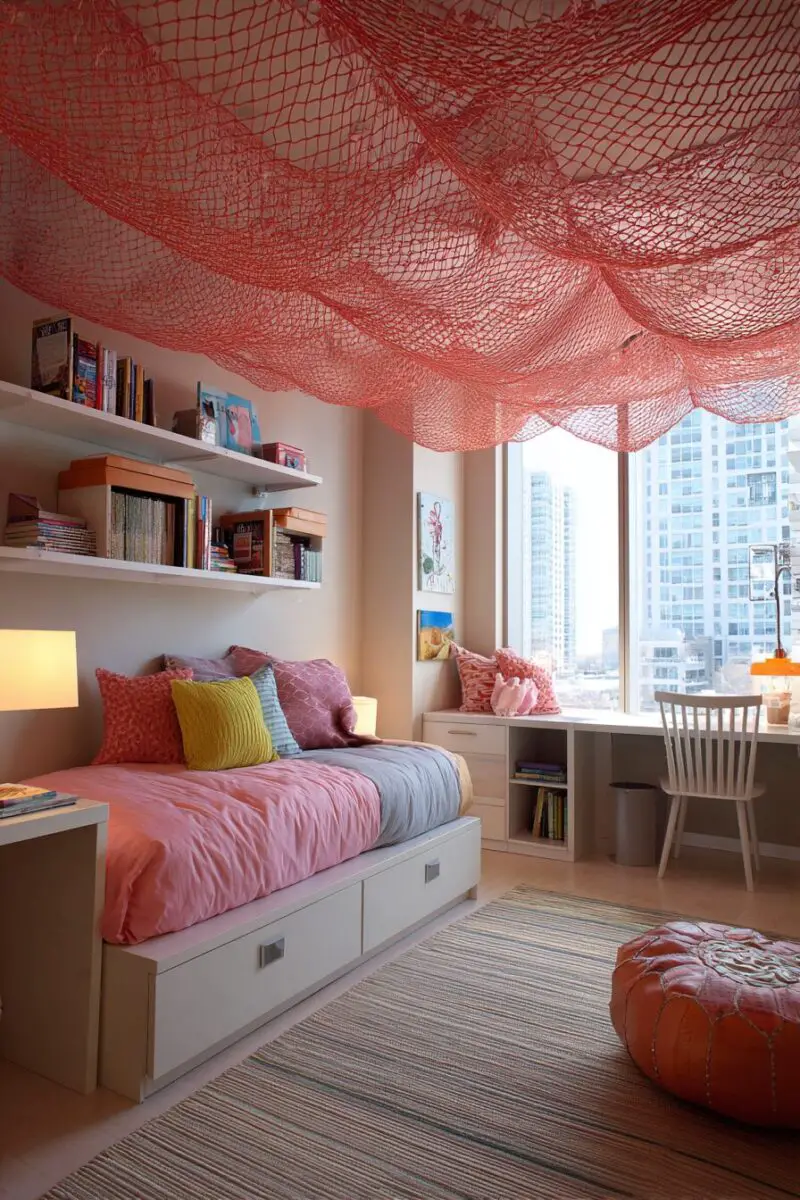
Overhead storage nets suspended from ceiling hooks create invisible storage space that keeps bulky items accessible but completely out of the way of daily activities.
These mesh systems work perfectly for storing stuffed animals, sports equipment, seasonal decorations, or extra pillows that don’t need daily access but still should remain reachable.
Children love the novelty of their “floating” storage, and tossing lightweight items up into the nets becomes a fun game rather than a boring chore.
Safety cables and proper mounting hardware ensure that ceiling nets remain securely fastened even when fully loaded with children’s belongings.
The transparent nature of storage nets means items remain visible and don’t create a cluttered or closed-in feeling like solid overhead cabinets might.
Different colored nets can designate personal storage areas for each child, maintaining the organization system while adding visual interest to the ceiling space.
Pulley systems attached to some ceiling storage solutions allow children to lower nets for easy access and raise them back up when finished, teaching mechanical problem-solving skills.
Seasonal rotation becomes effortless when you can simply swap out entire nets filled with summer or winter items rather than moving individual pieces.
The installation process requires proper ceiling joists and professional mounting for safety, but once installed, these systems provide years of reliable overhead storage.
Cleaning becomes easier since floor and furniture surfaces remain clear, and vacuum access improves dramatically with fewer items scattered around the room.
Some families use ceiling nets specifically for art projects and craft supplies, keeping creative materials organized but readily available when inspiration strikes.
This approach utilizes the most overlooked space in any bedroom while maintaining the open, airy feeling that makes small rooms feel larger and more comfortable for daily living.
Madison’s Current Obsessions
13 Dorm Room Hacks To Maximize Your Space And StyleWall-Mounted Desks: Homework Stations That Disappear

Fold-down desks attached to walls provide full-sized workspaces when needed and completely disappear when folded up, freeing precious floor space for other activities.
Each child can have their own dedicated workspace without the room feeling cramped or cluttered with bulky furniture pieces taking up permanent real estate.
Built-in organizers within fold-down desks keep pencils, papers, and supplies readily available while maintaining a clean, streamlined appearance when closed.
Adjustable height mechanisms mean these desks can accommodate children of different ages and grow with them over time, making them long-term investments.
Wall-mounted task lighting above each desk ensures proper illumination for homework and projects without requiring floor or table lamps that take up additional space.
Some designs include bulletin boards, whiteboards, or magnetic surfaces that fold down with the desk, providing inspiration and organization tools right at the workspace.
Cable management systems built into wall-mounted desks keep charging cables and computer cords organized and out of the way when the desk is in use.
The installation process, while requiring some wall reinforcement, creates a permanent solution that won’t wobble or shift like traditional desks might with active use.
Children love the novelty of their “secret” desk that appears and disappears, making homework time feel more special and less like a chore.
Parents appreciate that these desks don’t interfere with room cleaning, vacuum access, or furniture rearrangement since they’re permanently attached to walls.
Quality wall-mounted desks support significant weight and provide stable surfaces for computer use, art projects, or any other desk activities kids need to accomplish.
Madison’s Current Obsessions
These Moody Bedroom Ideas Are Turning Ordinary Rooms Into RetreatsMulti-Functional Nightstands: More Than Just Bedside Tables

Modern nightstand designs incorporate charging stations, storage compartments, and organizational features that serve multiple purposes in space-limited bedrooms.
Built-in USB ports and wireless charging pads eliminate the need for multiple adapters and charging cables cluttering bedside surfaces while keeping devices powered and organized.
Hidden compartments within nightstands provide secure storage for personal treasures, journals, or items each child wants to keep private from siblings.
Pull-out trays create additional surface space for snacks, books, or activities without requiring larger furniture pieces that would overwhelm the small room.
Some nightstands include small refrigerated sections perfect for keeping water bottles cold or storing medications that need temperature control.
Integrated lighting systems with dimmer controls help children wind down for bedtime while providing enough light for reading or other quiet evening activities.
Open shelving sections display favorite books, stuffed animals, or decorative items that make each child’s bedside area feel personal and special.
Cord management systems built into nightstands keep device chargers and lamp cords organized and prevent tangled messes that are difficult to clean around.
Matching nightstands create visual harmony in the shared room while giving each child their own personal bedside storage and surface space.
Some designs incorporate small safes or locked drawers for older children who want secure storage for money, special jewelry, or other valuable personal items.
The investment in quality multi-functional nightstands pays off through years of use and eliminates the need for additional furniture pieces that would crowd the small shared bedroom.
Creating a functional, beautiful shared bedroom for two kids doesn’t require a big space – it just requires big ideas.
With these clever solutions, you can transform any small room into a harmonious haven where both children feel comfortable, organized, and happy to call it their own.


